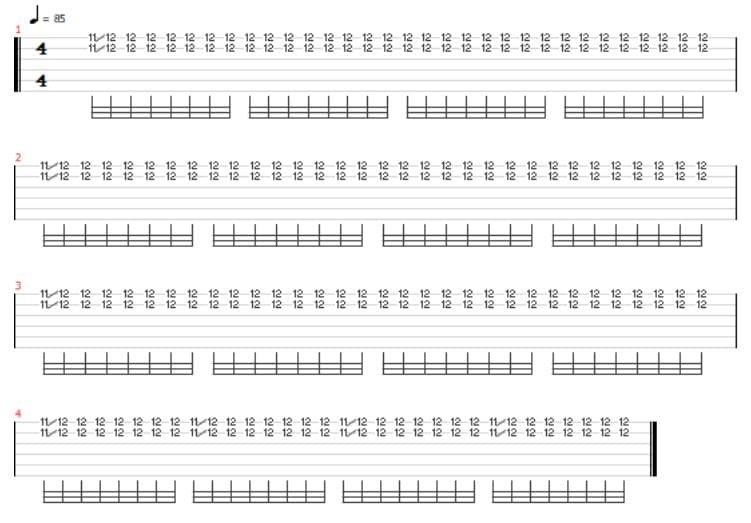Welcome to the vibrant world of guitar playing, where every strum and pick brings you closer to mastering your craft. One style that has captivated many guitar enthusiasts is the ever-popular "Rumble" sound. But what exactly is Rumble? In simple terms, it’s a captivating blend of rhythm and melody that often incorporates elements of rock and blues, offering a punchy and dynamic feel that’s hard to resist. Whether you’re an aspiring guitarist or looking to add a new flavor to your repertoire, exploring
Essential Guitar Gear for Playing Rumble

When you're diving into Rumble, having the right gear can make all the difference. Let's break down the essential equipment you'll need to get started:
- Electric Guitar: A solid electric guitar is crucial for achieving that iconic Rumble sound. Look for models with humbucker pickups for a thicker tone. Recommended brands include Gibson, Fender, and Ibanez.
- Amplifier: Your amplifier plays a vital role in shaping your sound. A tube amp is preferred for its warm, rich tones, but solid-state amps are often more budget-friendly. Brands like Marshall and Fender offer great options.
- Effects Pedals: Consider adding distortion and overdrive pedals to your setup. These will help you achieve that gritty, crunchy sound characteristic of Rumble music. Popular choices are the Boss DS-1 and the Ibanez Tube Screamer.
- Guitar Picks: The right pick can enhance your playing style. For Rumble, thicker picks (around 1.0mm) are recommended as they provide more control and better attack.
- Guitar Strap: Comfort is key, especially if you plan to play while standing. Look for a padded guitar strap that fits well and doesn’t dig into your shoulder.
- Capo: A capo allows you to change the key of your guitar easily, giving you more versatility while playing Rumble tunes.
Don’t forget to maintain your gear! Regularly check your string condition, clean your guitar, and keep your amplifier settings optimized for the best performance. As you get more comfortable with these essentials, you’ll find your own unique sound and style emerge within the Rumble genre!
Understanding the Chords Used in Rumble
So, you want to master "Rumble" on the guitar? One of the foundational elements of playing this iconic song is understanding the chords that bring it to life. The phrases and feelings that the music communicates really hinge on these simple yet powerful chord shapes.
Typically, "Rumble" utilizes a few key chords that are easy to grasp, especially for beginners. The main chords used are:
- A - A classic open chord that brings warmth and richness to the sound.
- D - Another staple in guitar playing that complements the A chord beautifully.
- E - This open chord rounds out the trio, providing a blend that's familiar and impactful.
Now, I know what you’re thinking: "Are these complex chords?" Not at all! These chords form the backbone of many songs, so once you get comfortable with them, you’ll find that your guitar skills will blossom. It's really about how you transition between these chords that counts. The beauty of "Rumble" lies in its simplicity, allowing you to focus more on your finger placement and strumming patterns.
So grab your guitar, familiarize yourself with the finger positions for each chord, and don't rush it. A steady hand will create a steady sound. Remember, practice makes perfect!
Step-by-Step Guide to Playing Rumble
Alright! You're all set with the chords, and the excitement is palpable. Let's break down "Rumble" step by step. Trust me, with a little practice, you'll be strumming this tune in no time.
- Tune Your Guitar: Before starting, make sure your guitar is in tune. This ensures all your chords sound as they should!
- Familiarize Yourself with the Chords: Make sure you can comfortably switch between A, D, and E. Try playing each chord for a count of four beats, then transition to the next.
- Strumming Pattern: The classic strumming pattern for "Rumble" is down, down-up, up-down-up. Practice this slowly before speeding it up.
- Start with A: Begin by playing the A chord, strumming with the pattern. Count along to keep your rhythm.
- Move to D: After playing the A chord for a few measures, switch to the D chord, maintaining the strumming pattern.
- Finally, E Chord: Transition to the E chord, sticking to the previously established rhythm. Repeat as you get comfortable.
It's all about repetition—you might stumble at first, but every great guitarist was once a beginner too. Combine patience with practice, and you'll soon have "Rumble" down like a pro!
5. Tips for Practicing Rumble Effectively
Practicing the Rumble technique on guitar can make a huge difference in your playing, but like any skill, it requires patience and the right approach. Here are some tips to help you practice Rumble effectively:
- Start Slow: Begin your practice at a slower tempo. This allows you to focus on your finger positioning and ensuring that every note rings clear.
- Use a Metronome: A metronome can help you maintain a steady rhythm. Try starting at a slow speed and gradually increase the tempo as you become more comfortable.
- Focus on Timing: Rumble relies heavily on rhythm. Make sure you’re tapping your foot or using a metronome to keep your timing spot on.
- Chunk Practice: Break the Rumble into smaller sections or phrases. Practice each section until you master it before moving on to the next one.
- Record Yourself: Listening to recordings can provide insights into your playing. You'll hear areas where you excel and spots that need improvement.
- Stay Relaxed: Tension can lead to mistakes. Make sure you’re relaxed while playing. Keep the posture natural, and take breaks if you feel strained.
- Alternate Techniques: Mix Rumble practice with other styles or techniques. This keeps your practice sessions interesting and helps solidify your overall skill.
By incorporating these tips, you'll not only improve your Rumble technique but also enjoy the journey of becoming a better guitarist!
6. Common Mistakes to Avoid While Playing Rumble
Even though the Rumble technique can be incredibly fun to play, beginners often make certain mistakes that can hinder their progress. Here’s a rundown of common pitfalls you should avoid:
- Lack of Consistency: Failing to practice regularly can stall your development. Set aside dedicated time for Rumble practice each week.
- Ignoring Rhythm: Rumble is all about rhythm. Neglecting this aspect can result in a disjointed performance. Pay close attention to maintaining a steady beat.
- Overexerting Pressure: Pressing too hard on the strings can lead to unwanted noise or even finger pain. Find the right balance between pressure and finesse.
- Skipping Warm-ups: Jumping straight into advanced Rumble without warming up can strain your fingers. Always start with some finger exercises or scales.
- Sticking to One Delivery: Rumble can be played in various styles. Limiting yourself to one delivery can stifle your creativity. Explore different ways to incorporate Rumble into your playing.
- Not Listening to the Music: Remember to play along with songs that feature Rumble. This helps you understand the context and application of the technique better.
Avoiding these common mistakes will set you on the right path to mastering the Rumble technique and enhance your overall guitar playing experience. Happy strumming!
Mastering Rumble on Guitar for Beginners
Learning to play the guitar is an exciting journey, and one of the most distinctive techniques that beginner players can master is the "rumble." This technique enriches your sound repertoire and adds a unique flair to your playing style. In this guide, we’ll walk you through what rumble is, how you can practice it, and offer tips for beginners.
What is Rumble?
Rumble is a percussive guitar strumming technique that incorporates both strumming and muted notes, creating a rhythmic and dynamic effect. It’s often used in various genres, from rock to folk, providing an engaging backdrop for melodies.
Steps to Master Rumble:
- Position Your Hand: Start by resting your palm lightly on the strings near the bridge of the guitar.
- Strumming Technique: Use a downward strum with your pick or fingers while simultaneously applying pressure with your palm to mute the strings.
- Vary the Rhythm: Experiment with different rhythms and strum patterns to develop a feel for the technique.
Practice Tips:
- Begin slowly, focusing on getting the muted sound clear.
- Use a metronome to keep time as you practice.
- Incorporate rumble into simple songs you know to make practice enjoyable.
Challenging Yourself:
As you become more comfortable with the rumble technique, try to incorporate it into different musical settings or genres. This will help standardize the technique and improve your versatility as a guitarist.
Conclusion and Encouragement for Beginners:
Mastering the rumble technique may take time and practice, but it's worth the effort. Embrace the learning process, and remember that every guitarist was once a beginner. Stay persistent, and soon, you'll find yourself incorporating rumble seamlessly into your playing!










